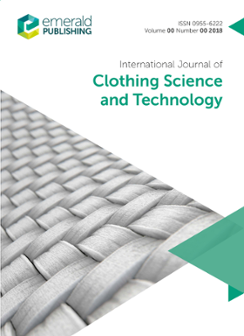International Journal of Clothing Science and Technology
Issue(s) available: 181 – From Volume: 1 Issue: 1, to Volume: 36 Issue: 4

Volume 32
Volume 28
Volume 23
Volume 21
Volume 20
Volume 19
Volume 18
Sustainable pre-treatment of cellulose knitwear in digital pigment printing processes
Martina Glogar, Sanja Ercegovic RazicIn the field of research on the application of digital printing to textile materials, there are still many research issues that arise from the very demanding interaction of…
How washing behaviors influence GHG emissions in textile use phase: a PLS-SEM analysis of household washing behaviors in Shanghai
Xiaoxiao Qiu, Shuaitong Liang, Shujia Wang, Shen Qian, Hongjuan Zhang, Xue Mei Ding, Jiping WangThis paper explores what factors influence household textile washing behaviour and how these factors relate to greenhouse gas emissions during the textile use stage.
Innovative 3D-printed surfaces for efficient water harvesting from air
Furkan Turan Koyun, Sema Sabur, Güldemet Başal, Hüseyin GünerhanThe purpose of this study is to develop nature-inspired 3D surfaces for atmospheric water harvesting.
Circular economy implementation and sustainability performance of the textile industry in an emerging economy
Yi-Hui Ho, Chieh-Yu LinThis study attempts to explore the association between circular economy implementation and sustainability performance for the textile industry in Vietnam. This study also…
A novel evaluation method of Chinese female lower body shapes based on machine learning
Xiaofeng Yao, Jinzhu Shen, Jianping WangThe purpose of this paper is to define the evaluation criteria for Chinese female lower body shapes and simplify the evaluation process of shapewear, including girdles, shaping…
Clothing suggestions based on comfort extracted from physiological and emotional parameters
Hyo Jung (Julie) Chang, Mohammad Abu Nasir Rakib, Md Kamrul Hasan Foysal, Jo Woon ChongThe comfort of apparel is not only a feeling of perception but also a tangible measure. The fit and fabric of clothing can exert a perception of comfort for the wearer, whereas…
Analysing the effect of mechanically recycled cotton fibres from pre-consumer wastes on mechanical and fastness properties of knitted fabrics
Burak Sari, Memik Bunyamin Uzumcu, Kubra OzsahinThe study aimed to investigate the impact of mechanically recycled cotton fibres from pre-consumer waste, blended with virgin cotton at varying ratios, on the mechanical and…
Textile wastewater: COD removal via Box–Behnken design, Fenton method, and machine learning integration for sustainability
Selman Turkes, Hakan Güney, Serin Mezarciöz, Bülent Sari, Selami Seçkin TetikThe widespread use of washing machines in textile dyeing and finishing boosts product quality while leading to significant wastewater production. This wastewater poses…
Study of hooked fiber in cotton yarn based on tracer fiber method
Xiangting Chu, Jian Gao, Hongdou Zhang, Huiwen Lu, Xinjin Liu, Xuzhong SuThrough the tracer fiber method, we strive to more accurately obtain the hook degree, straightening degree, percentage and other characteristic indexes. In order to intuitively…
Effect of layering outerwear on innerwear and air gap between the two layers on thermal comfort properties of knitted fabrics
Meghana Kammeta, N.K. PalaniswamyIn everyday life, people generally wear two layers of clothes (a knitted vest and a knitted t-shirt) during the summer. It is essential to understand which types of innerwear and…
Investigation of the effects of different needle hole covering techniques on seam characteristics of waterproof breathable fabric
Abhishek Kumar, Manpreet ManshahiaStitching is the traditional method of creating seams using needles and threads. However, this is not useful for waterproof breathable garments as needle holes allow water to…
Opportunities to reduce environmental burden by recycling fabric waste in a woollen fabric company
Duygu Yavuzkasap Ayakta, Şule Altun Kurtoğlu, Demet YilmazWool fiber is accepted as one of the natural and renewable sources and has been used in the apparel and textile industry since ancient times. However, wool fiber has the highest…
Relationship between firefighter protective clothing design ease and heat stress
Reannan Boisvert, Meredith McQuerry, Sheryl SchofieldClothing fit, including garment ease and drape, impacts the volume of air between clothing layers and the body, directly affecting the amount of heat that can be transferred…
The rise of sustainable approaches in development of waterproof breathable fabrics for garment: a systematic literature review
Abhishek Kumar, Manpreet ManshahiaThe aim of this study is to present an overview of sustainable practices in the development of waterproof breathable fabrics for garments. It aims to provide insights into the…
ISSN:
0955-6222Online date, start – end:
1989Copyright Holder:
Emerald Publishing LimitedOpen Access:
hybridEditor:
- Prof George Stylios
